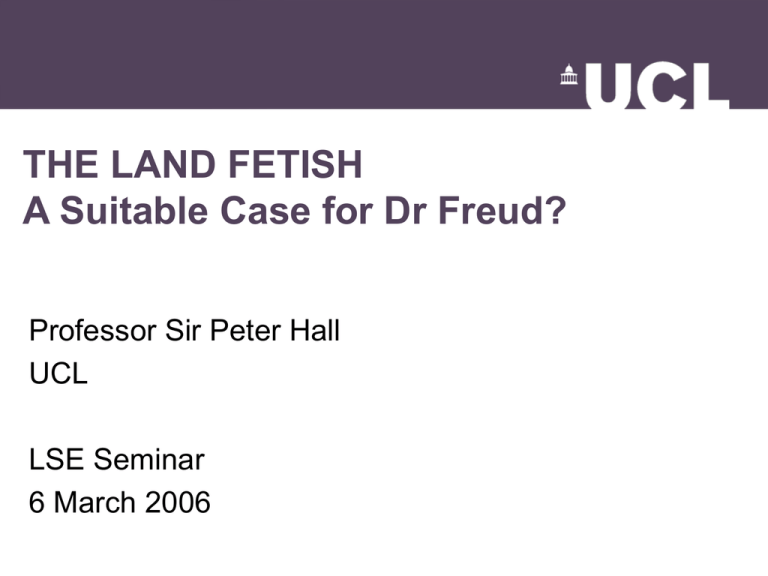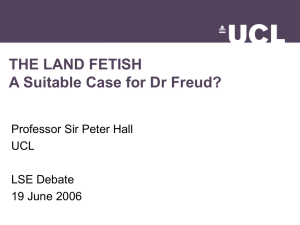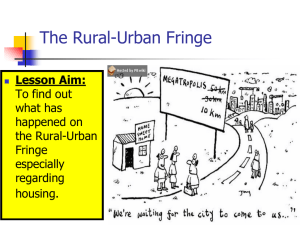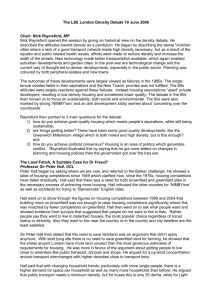THE LAND FETISH A Suitable Case for Dr Freud? UCL
advertisement

THE LAND FETISH A Suitable Case for Dr Freud? Professor Sir Peter Hall UCL LSE Seminar 6 March 2006 Planning in Britain: A New Verdict (1) • Andrew Gilg: Planning in Britain: Understanding and Evaluating the PostWar System (London: Sage 2005) Where Are We Now? Gilg’s Verdict • Middle-class bias • Not always democratic • Balances economic growth, conservation: a dilemma • Increasingly market-driven • No obvious alternative Where Are We Now? Gilg’s Verdict • Big Achievement: urban containment; preservation of countryside • Big Failure: development not sustainable: work, homes separate • Another Failure: transport not integrated; transport system overloaded • Need: integrated development; New Towns • Compare: Containment of Urban England (1973)! Where Are We Now? Planning in Uncertainty • • • • • Values and interests Essentially political Producers versus consumers Public action for private good Political cultures: very deep Where Are We Now? The Barker Challenge • Need for massive increase in housing completions • Will need brownfield + greenfield • “Political” attack by shires – “unholy alliance” with cities • The architects’ crusade: “Barcelonise” our cities A Continuing Issue? Brownfield, Greenfield and the Sequential Test Housing Completions: 1999, 2004 1999 % 000s 2004 % 000s 1999-2004 % change Total Brownfield Greenfield 100 56 44 140.0 78.4 61.6 100 68 32 152.9 104.0 48.9 +9.2 +32.7 -20.6 A Continuing Issue? Brownfield, Greenfield and the Sequential Test 1999-2004 Completions % change Brownfield % change Greenfield % change -8.3 +37.9 -39.5 0.0 +27.5 -43.1 Yorks Humber +5.9 +52.9 -41.2 East Midlands -6.8 +31.7 -28.4 West Midlands -9.3 +18.3 -42.0 Eastern England +5.4 +8.4 +1.3 London +92.8 +104.5 0.0 South East +10.0 +25.9 -16.1 South West +1.9 +50.0 -28.6 England +9.2 +32.7 -20.6 Region North North West Housebuilding: Houses v Flats 1999, 2004 Dwellings: % of total 1999 Houses 2004 Flats Houses Flats North East 88 12 83 17 North West 85 15 73 27 Yorks Humber 93 7 71 29 East Midlands 93 7 86 14 West Midlands *88 *13 71 29 East of England *91 *10 78 22 London 41 59 20 80 South East 83 17 62 38 South West 90 10 74 26 England 84 16 66 34 What do people want? • Home Alone (Hooper et al 1998): only 10% want a flat; 33% won’t consider a flat • CPRE (Champion et al 1998): people want to live in/near country • Hedges and Clemens (q. Breheny 1997): city dwellers least satisfied • Conclusion: we hate cities! Housing Preferences: MORI for CABE, 2005 • Over half the population want to live in a detached house • 22% prefer a bungalow • 14% a semi-detached house • 7% a terraced house • Detached house most popular choice, regardless of social status or ethnicity • Period properties (Edwardian, Victorian, Georgian) most desirable overall: 37% Good and Bad Arguments • Bad: we must save farmland • Good: we should give people choice of access to public transport, shops, schools • By public transport as well as car • So: concentrate growth around transport interchanges • And: raise densities there (“pyramids of density”) Land Lying Idle… • EU Set-Aside: June 2004, 476,000 hectares, almost 5.0% of England • Greater SE: 100,270 hectares, 8.6% • Essex 10.7% • Hampshire 9.1% • Oxfordshire 11.4% • Bedfordshire 11.6% • Far in excess of most generous estimates of land needed for housing! New Households, New Homes • 80% one-person • But only about one-third “single never married” • Will demand more space per household: Separate kitchens/bathrooms/loos, Spare rooms, Work spaces • Land saving reduces as densities increase: • 30 dw/ha yields 60% of all potential gains, 40 dw/ha 70 per cent • So biggest gains from minimising development below 20 dw/h, not increasing 40 dw/ha+ • So: go for 30-40 dw/ha with variations: higher close to transport services (Stockholm 1952!) • But won’t achieve same person densities as before! Densification: Effects Density Dws./ha. Net Land Saved % Total Saving Land needed to accommodate 400 dwellings Area required, ha. Gross (with local facilities) % Cumulative Land Saved % Total Saving % Cumulative 10 40.0 46.3 20 20.0 20.0 50.0 50.0 25.3 21.0 45.4 45.4 30 13.3 6.7 16.7 66.7 17.9 7.4 15.9 61.3 40 10.0 3.3 8.3 75.0 14.3 3.6 7.8 69.1 50 8.0 2.0 5.0 80.0 12.1 2.2 4.8 73.9 60 6.6 1.4 3.5 83.5 10.6 1.5 3.2 77.1 Density Gradient (Rudlin+Falk) Lessons from Land Use • Public Transport needs minimum density: • Bus: 25 dw/ha • LRT: 60 dw/ha • Exceed recent densities • Big gain from 30-35 dw/ha • Plus “pyramids” up to 60 dw/ha round rail stations • Urban Task Force • Traditional – Stockholm, 1952! • Or Edwardian suburbs! The Challenge • • • • • Building sustainable suburbs But: can be Garden Cities too! “New Towns”: seldom just that… More often: planned town expansions The need now: build sustainable urban places – linked along transport corridors • A big challenge for us: equal to 1950s, 1960s • They did it – so we can we! Where Are We Now? A 3-Pronged National Spatial Strategy • 3 key needs: • “Grow SEE”: Better connections on Sustainable Community Growth Corridors • “Shrinking the N-S Gap”: Bring North, Midland Core Cities/City Regions closer to London • “Grow City Regions” around Core Cities Where Are We Now? A New Geography of England… • Towards an “English Spatial Strategy”? • 4 SE Growth Areas • Plus Northern Way South East England: Global Mega-City-Region Urban Clusters (Hall+Ward 1998) Sustainable Communities Corridors: Growing the SE into the Midlands… The Infrastructure Gap: Roger Tym Report The North: Managed Decline? • The great Pathfinder row • How much to keep? How much to demolish? • Are incentives perverse? • YES: SAVE Britain’s Heritage • NO: ODPM • Family-Friendly Housing in Cities • How much Greenfield? • Issues: VAT, Infrastructure (Manchester, Leeds, Liverpool) Shrinking the N-S Gap: Slowing Traffic, Speeding Trains… Shrinking the N-S Gap: A New High-Speed Line? Shrinking the N-S Gap: From Core Cities to City Regions • Eight city regions: key to faster economic growth in North • Build on renaissance of Core Cities • 90% of population, more than 90% of economic activity/assets • Most of North’s growth here • 50% higher per capita GVA growth than rest of North City Regions: Accessing the Core City… London Euston to Manchester Piccadilly Outward Journey on Fri 2 Sep 2005 Option 1 2 3 Depart 07:35 08:05 08:35 Arrive 09:48 10:24 10:48 Duration 2:13 2:19 2:13 Changes 0 0 0 City Regions: …and Periphery (not quite, actually!) London Euston to Oldham Mumps Outward Journey on Fri 2 Sep 2005 Option Depart 1 07:35 2 08:05 3 08:35 Arrive Duration Changes 10:44 3:09 2 11:35 3:30 2 11:44 3:09 2 Making it happen: The 2004 Act • • • • • • • Radical change – biggest for 35 years Working through at regional strategic level Still to work through at local level Planning Gain Supplement Can it solve the “infrastructure deficit”? The major issue in solving the housing crisis! But also: the NIMBY factor – will get worse? Planning Gain Supplement v. S106 • Planning Gain Supplement (i.e. development land tax) on windfall gains by developers • Could vary locally: brownfield v. greenfield • Can it meet the “infrastructure gap”? • Or are existing mechanisms as effective? • MK, Bedford… • So retain “Section 106” as an alternative? • Local versus regional investment: ‘local gain’ for ‘local pain’ (retention of PGS; higher proportion of Council Tax receipts from new housing) • But problem of regional infrastructure: Bypasses v. new rail connections… • Need for better integration ODPM/DfT! SE Orbirail, Manchester Metrolink, etc, etc… Summing Up: Key Challenges • • • • • • • Deliver the houses Defend the “balanced portfolio” Demonstrate its sustainability Resist vested interests Fund the infrastructure Coordinate development, transport Countryside – for people!






